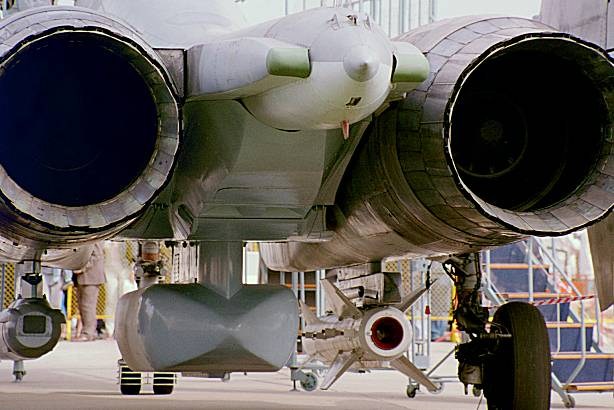
Vietnam is Russia’s Biggest Arms Customer
Publication: Eurasia Daily Monitor Volume: 7 Issue: 22
By:

It may surprise readers to learn that in 2009 Vietnam was Russia’s best customer for its arms exports (www.defensenews.com, January 21). During 2009, Vietnam bought six Russian kilo-class submarines and 12 Su-30MKK fighters (Hanoi, VNEXpress, December 16, 2009; Kommersant, December 18; Interfax, December 15; RIA Novosti, December 4). While Vietnam most likely bought these weapons to counter the growing might of the Chinese navy and its continuing claims to the Spratly Islands off Vietnam’s coast, the motives for both sides are deeper. Although Vietnam’s fleet is antiquated, it clearly has decided to develop those capabilities to counter China’s claims and power (Agence-France Presse, December 17). Nonetheless, both sides have a broader agenda.
For Hanoi, this deal involves more than simply buying weapons. It reportedly entails the construction of naval infrastructure in Vietnam, including a naval base, repair and maintenance facilities, and a communications center, as well as the training of specialists (www.defensenews.com January 21). However, it also is part of an ongoing arms buildup. Vietnam’s leadership has been traveling the world seeking military sales from the US, Canada, and France (Straits Times Online, January 4). Beyond the search for arms and related infrastructure to meet the Chinese challenge, it has clearly made a major gesture to Moscow to upgrade bilateral relations also to counter China. Thus, Vietnam wants Russia to participate in its priority projects, seeking low-interest Russian loans resembling those granted by the Japanese Official Development Assistance (ODA). It also is pushing for a bilateral free trade agreement (ITAR-TASS, December 14). Beyond that, it apparently is offering Gazprom a stake in Petovietnam gas, Vietnam’s gas distribution firm (Interfax, ITAR-TASS, December 15). Moreover, Hanoi promised to facilitate Russian investment in Vietnam and wants Russia to build its first nuclear power plant (Vietnam News Agency, Interfax, December 15). Thus, the Vietnamese government is soliciting a large-scale Russian presence in its country to balance Chinese economic and political power, and ensure its energy security, even as it also seeks to check Chinese naval power in the South China Sea.
For Moscow, this deal offers many incentives, but it equally raises some significant questions. There is no doubt that Moscow has long sought to sell arms to Southeast Asian states on a regular basis and develop energy cooperation with them. It has sold arms to Indonesia in the past. And during 2009, it was busy trying to interest states like Brunei, Malaysia Thailand, and Myanmar in both its military and energy products (ITAR-TASS, Interfax October 14; Interfax, October 19; RIA Novosti, August 19; Interfax, December 4; Bangkok Post, January 1, 2010). The Irkut Corporation, for example, is ready for joint drone projects throughout Southeast Asia (Interfax, December 4). Indeed, in late 2009 Myanmar bought 20 MiG-29 fighters and 6 to 10 Mi-35 helicopters from Russia (Pravda, December 24).
While these deals attest to local states’ heightened anxieties about China, they also represent an opportunity Moscow has long craved to play on a global as opposed to regional stage. Russia has long implied that its weapons’ quality signifies its greatness on the world stage, which explains the domestic alarm about Algeria returning planes and the failure of the Admiral Gorshkov to be built on time for India, as well as repeated examples of the poor quality of Russian weapons, since it strikes at Moscow’s amour-propre. Conversely, these sales will be used to justify Moscow’s standing as an Asian and global power, even though weapons and oil are about all that Moscow has to offer and the former’s quality is decidedly dubious, given its past record.
Moscow is also seeking to reorient its arms sales base away from China, because of Chinese piracy and since Beijing also wants the highest technology products Russia possesses –a desire that raises Russian suspicions over China’s intentions (Interfax, January 28). Nonetheless, this is a course that raises some interesting problems. Despite the strains in the Sino-Russian arms relationship, China still buys a large proportion of Russian arms and remains a major customer for Moscow (RIA Novosti, January 31).
At a time when Moscow is falling deeper into obligation to Beijing in the Russian Far East, a turn away from China toward states who are clearly building up their armed forces to counter growing Chinese capabilities and potential threats would not sit well with Beijing and might undermine the previously close bilateral relationship. Neither should one overestimate the presence Russia can have in Southeast Asia, as apart from guns, nuclear power, and oil it has nothing to offer these states and China’s economic power throughout the region and willingness to use it are clearly growing, a process that on the one hand contributes to Southeast Asian apprehension, but on the other is an extremely powerful factor in their policies.
Russia may be beginning to feel pinched by Chinese economic power and growing military might and may be seeking to rebalance its Asian profile through such sales to Southeast Asian states. But it remains to be seen just how much influence the connection to Russia gives these states, and vice versa the level of leverage its presence in Southeast Asia gives to Russia vis-à-vis China in Asia. As the Chinese proverb notes, “distant water cannot quench a nearby fire.” For Russia, Vietnam, and Southeast Asia, China is the nearby fire and these states relate to each other in fact as the distant water and so it will be most interesting to see just how sustainable the previous Sino-Russian partnership remains under the new strains generated by China’s rise and the regional as well as global repercussions of China’s rising power.




